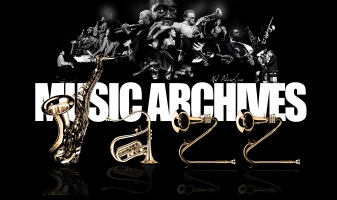Johnny Griffin – ‘Live At Ronnie Scott’s 1964’(Gearbox Records RSGB1010CD. Album review by Len Weinreich)
Question: How many vertically-challenged Afro-American jazz tenor saxophone masters have travelled the highway between Chicago’s South Side of Chicago and the rural Poitou region in France to become master of a château? Answer: a number that lies precisely midway between zero and two.
The saxophonist in question was the diminutive Johnny Griffin, one of a pair of tenor players nicknamed ‘the Little Giant’ (homegrown Tubby Hayes was the other). Griffin’s regular billing was ‘the fastest gun in the west’, recognising his prodigious technique and unquenchable flow of ideas. After paying funky dues in R&B bands, he locked horns with tenor rivals as formidable as Arnett Cobb, Gene Ammons and Hank Mobley, emerging as a seasoned bebopper working with Thelonious Monk and Art Blakey.
But, in 1963, unable or unwilling to face the combination of a painful meeting with the U.S. Internal Revenue Service, a disintegrating marriage and a visceral distaste for the free jazz movement, he slipped out of the U.S. and settled in France.
Meanwhile, back in London’s Soho, Ronnie Scott, another tenor player, had recently converted a primitive cabbies’ basement refuge into a slightly less primitive refuge for modern jazz musicians. At minimal expense. Facilities like loos and seating verged on the Neolithic. It’s possible that the club piano had survived the Blitz. Accessed by a flight of steps descending into the unsanitary bowels of Gerrard Street, Ronnie Scott’s Club Mk. 1 was suitable only for committed fans with stout hearts and firm glutes, stoically indifferent to comfort. In selecting headline performers, Scott was happiest starring his U.S. tenor heroes like Zoot Sims, Al Cohn, Hank Mobley and now, closer at hand, Johnny Griffin.
On the 8th of January 1964, Griffin has star billing and Les Tomkins is running a tape deck recording a band soon to be recognised as a legendary ensemble: pianist Stan Tracey, bass player Malcolm Cecil and drummer Jackie Dougan. All on top form.
Unlike the January weather outside, Griffin’s tone is rich, warm and mellow. His approach is over-endowed with what trombonist/writer Mike Zwerin has called ‘the cry’, the authentic deep-down essence of jazz. Considering the speed of his delivery, his articulation is clean but he’s no stranger to bending notes. Track one, Hugh and Blane’s ‘The Girl Next Door’, is taken at jaunty tempo over a shuffle beat, drummer Jackie Dougan dancing at the drums (and playing brilliantly throughout). After about a chorus and a half, Griffin is fully warmed up and unstoppable, firmly supported by Malcolm Cecil’s bass. He spins new ideas, moulds fresh phrases, expanding them, demonstrating his ability to turn them inside out in flurries of notes and wit, treating rhythm and melody like potter’s clay.
Then it’s Tracey’s turn. Unfortunately, the album’s sole drawback is that Tomkins’ microphone wasn’t totally pointed in Stan Tracey’s direction and so his work, while audible, isn’t exactly the highest of fi, not forgetting the piano’s dubious history. But don’t dismay because Tracey’s artistry carries us through and the music is superb. Leaning on Cecil’s powerful bassline, Tracy adopts a spare melodic single note line that soon broadens into generous block chords, paying hommage to Duke, Basie and Monk, eventually developing into an intense musical duet with Cecil towards the end of his solo. Griffin returns and puts it all to bed by restating the theme elaborately garlanded with ornament.
It’s said of jazz wits that, on learning of incidents with bridges in the Great State of Indiana, they’d comment: “but there ain’t no bridge in Indiana” owing to the boring fact that Hanley and MacDonald’s composition, (Way Back Home In) Indiana lacks the conventional middle eight bars (a.k.a.: the bridge [U.S.]). This made the song a jazz staple (and its chord sequence the underpinning of Charlie Parker’s finger-busting Donna Lee).
It’s also said that Griffin was never entirely happy with his PR moniker ‘fastest tenor in the west’ (a Selmer Mk 6-shooter?). However, his Indiana solo demonstrates conclusively how it was earned. Having set the tempo to high blister, he dismisses the theme in a few desultory brushstrokes before energetically constructing a new impressive edifice from loose fragments, stray tones and unusual slashes of melody, every now and then testing the rhythmic structure, while maintaining tempo. In effect, a roller-coaster ride for hipsters.
In contrast to Griffin’s frontal assault on the senses, Tracy opts for space and silences, cagily shifting asymmetrical musical shapes then breaking the pattern with crashing clusters of monumental chords. Griffin re-enters in an electrical interplay with Dougan as they indulge in jazz as an extreme sport before stamping on the brakes with a sudden, brusque ending. A tour de force.
On Blues In Twos, an original so basic that it might have taken forty seconds to compose, Griffin revels in the smoky roadhouse riffs and R&B memories of his early days, before he triggers an explosion of bebop fireworks, a furious musical intelligence at play. Again, when Tracy’s turn arrives, he goes minimal, wisely entering sotto voce, forming and reforming phrases, creating rhythmic tension before a series of dramatic block chords and an absorbing duet with Malcolm Cecil. Then we’re treated to riveting exchanges between tenor and drums. Stirring stuff.
The album closes with a under two-minute micro-version of Miles Davis’ theme tune, The Theme, converted by Griffin’s speed and virtuosity into yet another tenor tornado. And finally, as the applause subsides, we’re treated to the unmistakeable voice of maestro Ronnie Scott himself. A potent dose of nostalgia.
Caspar Sutton-Jones and Darrel Sheinman should be saluted for performing miracles, extracting so much music from 59-year-old tapes. Furthermore, at a time when most album information is seldom more than over-hyped puffery or fawning acknowledgement, Richard Williams’ accompanying sleeve notes are written with customary elegance, skill and erudition, a model of enlightening information and incisive criticism. Respect.
Johnny Griffin, tenor saxophone; Stan Tracey, piano; Malcolm Cecil, bass; Jackie Dougan, drums. Ronnie Scott’s Club, 39 Gerrard Street, London, 8 January, 1964. Gearbox Records RSGB1010CD (also available on vinyl). Released today 10 November 2023
LINK: Johnny Griffin at Gearbox Records /
from https://londonjazznews.com
Edited by snobb - 10 Nov 2023 at 6:57am






 Post Options
Post Options
 Thanks(0)
Thanks(0)
 Quote
Quote  Reply
Reply
 Topic: ‘Johnny Griffin – Live At Ronnie Scott’s 1964’
Topic: ‘Johnny Griffin – Live At Ronnie Scott’s 1964’

